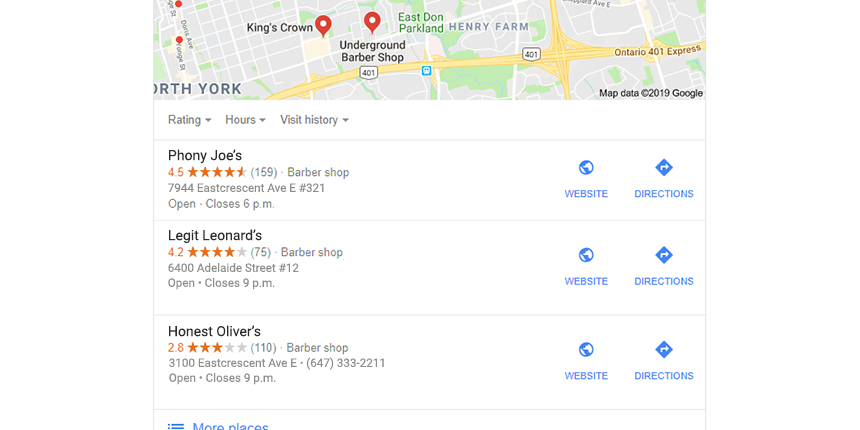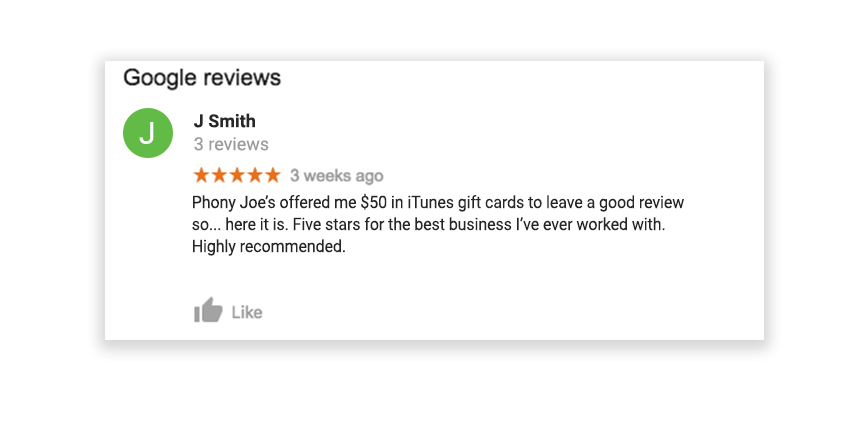
Maximize your local presence through strategic location management.

If you’re working hard to get your business locations listed on the Google Local 3-Pack, you know how heartbreaking it is to be outranked by a spam listing. Fortunately, there are ways to fight back against fake listings, phony reviews, and other spam symptoms that keep your Google My Business pages from reaching their potential. But before we explore the most effective remedies, we first have to ask ourselves…
In our experience, there are three types of spam most common on Google My Business. Once you learn how to identify the tell-tale signs—and understand how each type can affect your business—the fightback can begin.
These are listings for businesses that either don’t exist at all or do exist but have no physical location or service area. They may be fake places of businesses using a mailbox or virtual office to qualify for GMB listings. Although they’re supposed to be staffed during the hours of operation listed on their profiles, they are often empty.

We also see people using multiple home addresses in order to create multiple false listings. Most commonly this is done by lead-generating companies that sell their leads to real businesses.
Keyword stuffing is the practice of adding several descriptive keywords into a business name and/or description which are not part of the real-world business. For example, a business named “Crystal Law Firm” may spin its GMB name into “Crystal Divorce & Family Law Attorneys in Orange County”. This has been a surprisingly effective local SEO tactic, but Google is taking steps to combat keyword stuffing—thanks, in part, to other local businesses reporting it.
This is one of the most common types of spam in listings and also one of the hardest to resolve. Not only can fake positive reviews be purchased by shady businesses, but upstanding businesses may suffer from fake negative reviews through no fault of their own.
In total, there are four types of positive reviews that go against Google’s Terms of Service: gated reviews (i.e. “cherry picked”, where real customers are selectively solicited to leave glowing reviews); non-customer reviews, such as those made by employees or other peers; reviews obtained from other businesses by offering to leave them a positive review in return; and any review that has been incentivized.

On the other side of the coin, there are also different kinds of negative reviews that fall foul of Google’s terms, including: reviews for the wrong (i.e. misidentified) business; biased reviews, such as those left by someone who promotes a competing business; reviews that are motivated by a controversial news story; and reviews on multiple locations of the same business regarding an experience at a single location.
If you think you have found a spam listing or fraudulent reviews, your first act should always be to alert your dedicated DAC account rep! As Google partners, we’re able to take quick, decisive action to remedy any kind of local search issue.
But if you’re not a DAC client, don’t worry: here are four simple ways you can fight back against local listings spam yourself.
Subscribe to our monthly newsletter.
You can publicly edit an inaccurate, keyword-stuffed listing or report the listing if it is spam. This works best for locations that have not been claimed, but edits and reports are reviewed by Google whether or not a business listing is claimed. Fortunately, fake reviews are normally fairly easy to detect, so simply flagging them on your own is often an effective way to kick-start the removal process.
If your business has attracted fake negative reviews, you can respond to them in order to signal to your prospects and customers that a) the review is false and b) you’re working towards having it removed. Of course, responding to negative reviews—whether or not they’re legitimate—is something you should be doing anyway (and if it’s proving to be too frustrating and time-consuming, our TransparenSEE dashboard might be just the solution you need.)
Posts in the Google My Business Community are often investigated by Google themselves. However, this forum is actually run by volunteers, which means response times can vary—and some threads may never receive an official response. So it may be worth trying to tackle some issues with the help of this community, but, again, your best bet is to reach out to your DAC account rep.
You can direct-message Google My Business on Twitter or Facebook if you want to report a spammer or competitor that is breaking the rules. As a private channel, direct messaging will ensure you’re not outed as the whistle-blower—but that confidentiality also means you may not be notified if and when the case is resolved. Check back in a few weeks to see if the listing you reported is still an issue, and remember that you can only contact GMB via phone or chat if the issue pertains to your own listings.
It’s never been more important to keep your online listings in good health, whether it’s by proactively maintaining them or by trying to level the uneven playing field imposed upon them. But it’s a slow, grinding task to redress the kind of complex, pervasive issues that even Google fails to detect and prevent.
Instead, people are key. When spam slips through all technological safeguards, a strong human element—and constant, ongoing vigilance—is the only way to restore parity and get your local SEO back on track. That’s exactly what you’ll find with our unique Active Management approach to local listings. Want to know how we do it? Contact DAC.
Maximize your local presence through strategic location management.
Maximize your local presence through strategic location management.
Subscribe to our monthly newsletter.